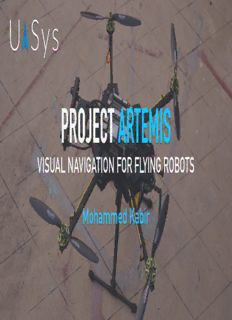
Project Artemis PDF
Preview Project Artemis
PROJECT ARTEMIS VISUAL NAVIGATION FOR FLYING ROBOTS Mohammed Kabir PROJECT ARTEMIS STATE OF THE INDUSTRY Highly dependent on GPS in assisted modes. • Requires sufficient piloting skills in non GPS-assisted modes. • Chance of ‘flyaways’ due to bad GPS reception. • Immediate need for robust GPS-agnostic navigation methods. • No environmental awareness. • Not truly autonomous. • PROJECT ARTEMIS CHALLENGES Multicopters are highly dynamic • systems. They are inherently unstable and • require active control strategies for stable flight. System dynamics are coupled and fast. • Limited in terms of onboard computing • and sensing hardware that can be carried. QoS for wireless datalinks to the MAV • cannot be relied on in all environments. PROJECT ARTEMIS THE NAVIGATION PROBLEM Perception Localisation Operator interface Navigation Planning Control PROJECT ARTEMIS LOCALISATION We use a SLAM (Simultaneous • Localisation and Mapping) technique on our robot. Visual SLAM is globally consistent, • and centimetre-level accurate unlike GPS, and works indoors and outdoors. Tight fusion with time-synchronised • inertial measurements greatly increases robustness and accuracy. PROJECT ARTEMIS VISUAL-INERTIAL LOCALISATION PROJECT ARTEMIS PERCEPTION Multiple cameras provide proprioceptive • information about the environment. All the cameras and the IMU (Inertial • Measurement Unit) are synchronised in time with respect to each other. Forward stereo cameras are • used to compute depth images in realtime. Depth images are used to build • a 3D map of the environment is built incrementally. PROJECT ARTEMIS AUTONOMOUS EXPLORATION AND MAPPING PROJECT ARTEMIS SENSING SUITE Credit : Framerate Stephan Weiss, PhD thesis 2012 (dynamics) High Ideal sensor Compass IMU t f i r D n o i t c e r r o c Medium Cameras, Laser Rangers t f i r D n o i t c e r r o c Low GPS Drift speed None Medium (spatial) Fast (temporal) PROJECT ARTEMIS STATE ESTIMATION The system is designed to navigate using all available • sensors in the environment - GPS, Vision and Lidar. Sensor availability is not guaranteed - modular sensor • fusion approach using a hybrid Kalman filter with fault detection is used. Even if a particular subset or module were to fail, the • overall system performance would not be compromised.
Description: